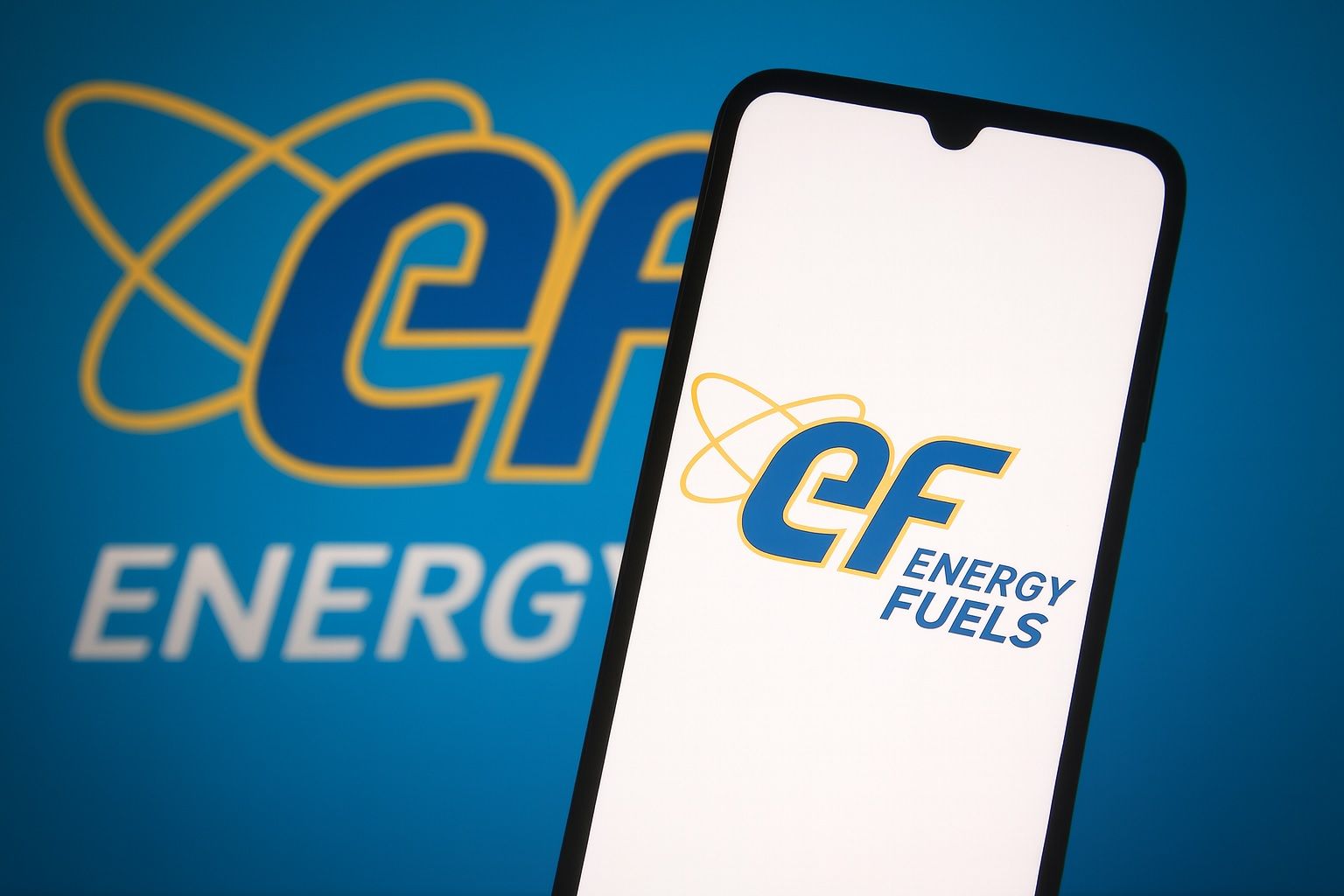- Price (Oct 13, 2025): ~$20.34 USD (closed Oct 10) [1], up ~275% over the past year [2].
- Market Cap: ~$4.7 billion [3]; ~230.7 M shares outstanding [4].
- Business: Leading U.S. uranium miner and growing rare-earth processor, plus vanadium and heavy-mineral sands. Owns the White Mesa Mill (UT) – the only licensed conventional uranium mill in the U.S. [5] [6] – and the high‑grade Pinyon Plain uranium mine (AZ) [7].
- Recent Catalysts: Closed a US$700 M convertible debt raise (0.75% coupon, 2031 notes) [8]; achieved pilot success turning NdPr rare-earth oxide into EV magnets [9]; produced 99.9% pure dysprosium (Dy) oxide for heavy‐REE magnets [10].
- Financials (TTM): Revenues ~$65 M; net loss ~$93 M [11] (driven by ramp-up costs). Working capital ~$253 M (June 30, 2025) [12]. No debt net of cash [13].
- Analysts: Consensus “Buy/Strong Buy” [14]. Average 12–18 mo. price targets are varied (~US$12–22 range); Public.com cites ~$13.38 [15], while B. Riley recently set a US$22 target [16]. Short interest is high (~12% of float) [17].
- 52‑week Range: $3.20–22.37 [18]. Stock is extremely volatile (beta ~1.5; 84% annualized vol [19]).
Recent News
- Oct 3, 2025: Convertible Debt Raise. Energy Fuels closed an upsized US$700 M offering of 0.75% convertible senior notes due 2031 [20]. Demand was strong (oversubscribed, extra US$67.5M sold) and marked a rare U.S. capital markets victory for a raw-miner. Notes convert at ~$20.34/share (Sept 30 price) [21]. CEO Mark Chalmers said this “reflects strong investor sentiment not only regarding our rare earth initiatives, but also our low-cost, U.S.-leading uranium production” [22]. Proceeds fund growth projects (rare-earth expansion at White Mesa Mill, heavy-mineral sands development in Australia) and cover option costs [23] [24].
- Oct 1, 2025: Pricing of Convertible Note Offering. The company priced a $600 M tranche of 0.75% notes (due 2031), up from an initial $550 M [25]. The offering was to close Oct 3 and also included a full “greenshoe” exercise for an extra $100 M. The notes’ conversion price was set at ~$20.34 (a 32.5% premium) [26], illustrating market confidence. EF noted these funds will also pay for capped-call hedges (~$46 M) and further invest in rare-earth and uranium capacity [27].
- Oct 10, 2025: Rare-Earths Surge on Trade News. U.S. stocks of rare-earth miners jumped after President Trump threatened new tariffs on China (including rare-earth exports) [28]. USA Rare Earth surged ~19%, MP Materials ~15%, and Energy Fuels +10% intraday (settling around +4%) [29] [30]. The surge was partly fueled by China’s announcement (Oct 9) of sweeping rare-earth export controls [31] [32]. This highlighted U.S. reliance on China (which processes ~90% of global rare-earth magnets [33]) and sent EF stock +9% on Oct 9 [34]. Energy Fuels commented it is “working to boost U.S. rare earths production” and that its recent pilot “showcases the technical capabilities of an American company on American soil” [35].
- Aug/Sept 2025: REE & Project Milestones. The company achieved several breakthroughs: in September it announced that NdPr oxides from EF’s Utah mill were successfully made into EV motor magnets by a global supplier [36]. In August, EF produced its first 99.9% pure dysprosium oxide at White Mesa, and expects the first terbium oxide samples by Q4 2025 [37]. The U.S. EPA-approved construction plan for the Donald project in Australia (a large mid/heavy RE + mineral sands deposit) in Q2 [38] unlocked a major asset. These developments helped fuel a ~194% stock rally in three months, according to a Zacks report.
Company Overview and Strategy
Energy Fuels’ core operations include the Pinyon Plain high-grade uranium mine and the White Mesa Mill in Utah (pictured). It was founded in 1987 and today is “a Colorado-based player in… critical minerals — think uranium, rare earth element (REE) processing, vanadium production, and heavy mineral sands operations” [39]. The company has been the leading U.S. producer of uranium concentrate for several years [40], supplying nuclear utilities for carbon-free power. It owns multiple uranium assets (conventional and ISR) and in 2024-25 ramped up Pinyon Plain (AZ) to record grades and output [41]. Energy Fuels also operates the White Mesa Mill (UT) – the only conventional uranium mill in the country [42]. At White Mesa, it processes ore and tailings: converting monazite sands (imported from domestic sources) into separated rare-earth oxides (NdPr, Dy, etc.) and recovering vanadium or medical isotopes when possible. This dual focus makes EF unique among peers.
Strategically, EF is pivoting into rare earths to leverage that mill. Management highlights the goal of a “mine-to-magnet” U.S. supply chain for EVs and defense. CEO Mark Chalmers says their recent magnet breakthrough is a “decisive breakthrough in building a supply chain independent of China” [43]. The company plans commercial production of heavy rare-earth oxides (Dy, Tb) by 2026 [44], complementing the light REEs (NdPr) already qualified for magnets. In summary: EF combines high-grade uranium mining (for nuclear fuel) with emerging critical-minerals processing, aligning with U.S. policy to onshore nuclear fuel and REE supply chains [45] [46].
Market Position – Uranium
In uranium, EF is a Tier-1 U.S. producer among a small field. It led U.S. output (supplying ~2/3 of U.S.-mined uranium from 2017–2023) [47]. Its Pinyon Plain mine is noted for exceptional grades (costs ~$23–$30/lb U₃O₈) [48], giving a competitive cost advantage if uranium prices recover. By contrast, global giants like Cameco (Canada) and Kazatomprom (Kazakhstan) dominate internationally, and smaller peers (Uranium Energy Corp, NexGen, etc.) have lower-grade or in-situ projects. U.S. policy is now very supportive: the DOE plans to buy more domestic uranium and build a strategic reserve [49] (driving EF stock +9% on the news [50]). This comes amid an urgent push to replace Russian supply. As one analyst noted, U.S. “nuclear fleet depends heavily on foreign supply” and EF is a key local supplier [51].
Demand-wise, nuclear energy is seen as a clean-baseload growth area, strengthening the market long-term. Short-term uranium prices have risen into the mid-$70s/lb but still remain below many producers’ breakeven [52]. EF’s strategy is to lock in forward contracts now (guidance raised to 350,000 lbs in 2025) so that higher prices later yield big gains. In sum, EF’s uranium market position is strong domestically (only a few U.S. mines compete), with government tailwinds, but it faces a volatile commodity with price risk [53] [54].
Market Position – Rare Earth Elements (REEs)
Rare earths (NdPr, Dy, Tb, etc.) are crucial for EV magnets, defense, and high-tech. Historically 100% of processed REEs (and ~90% of magnets) came from China [55]. U.S. supply has been negligible, relying on foreign ore imports. EF is one of only a few Western companies moving up the value chain. It processes monazite sands at White Mesa and has started to separate heavy RE oxides. For example, it produces mixed RE carbonates which it previously shipped to Europe for refining [56]. It now has a pilot heavy-REE separation line (99.9% pure DyOₓ) and plans full-scale heavy RE separation by 2026 [57].
In the light-REE space (NdPr), EF’s NdPr oxide has been EV-tested. The company says its new NdPr feedstock “powered EV and hybrid motors” in overseas trials [58]. Meanwhile, they partner with Vulcan Elements to create a U.S. magnet supply chain (supplying NdPr and Dy to Vulcan for magnet blanks) [59] [60].
Competition: MP Materials (MP) and Lynas (LYC) are far ahead, with larger mines and plans to make magnets (MP has Apple/Defense contracts). Smaller U.S. projects (USA Rare Earth – USAR, Ucore, Rare Element) are still in development, with little production. A TS2 analysis notes EF’s RE revenue is still very small (<$5M) and it “doesn’t aim to make magnets” itself [61] [62]. Rather, EF is staking out a niche in processing and refining. The recent surge in RE prices (Chinese NdPr up ~20% to ~$74/kg, Dy/Tb multiples of $800-$3,600/kg) [63] has improved EF’s economics. Overall, EF is well-positioned in U.S. REEs (only U.S. separation facility [64]) but still far from the scale of China’s supply chain. Its role is as a domestic supplier building critical capacity, while riding the wave of U.S. industrial policy favoring onshoring of rare-earth supply.
Financial Performance & Fundamentals
Energy Fuels is still in investment mode. In Q2 2025 it reported only $4.21 M revenue (mostly uranium & some HMS sales) versus $8.72 M a year ago [65]. Net loss was $21.8 M (loss of $0.10/sh) [66], much wider than last year’s loss of $6.4 M. The swing reflects startup costs (and no significant uranium sales yet). For the trailing 12 months, revenue ~$65 M vs. net loss ~$93 M [67]. Despite losses, the balance sheet is strong: working capital ~$253 M (up 48% YoY) [68], with essentially zero net debt [69] (thanks to recent financings).
Key metrics from Finimize: EF has an EV/Sales ~15.7x (very rich) [70] and no forward P/E (due to losses). Operating margins remain deeply negative [71]. The company is burning cash on REE expansions (FCF yield ~–21.8% [72]) and has a large convertible note ($700 M due ’31) that could dilute equity [73]. On the plus side, record uranium output at Pinyon Plain and progress on rare-earth assets mean booked losses may turn to cash flow after 2026. Currently, analysts note that performance hinges on commodity prices and project execution. As a data point, two buys/one hold is the current analyst split [74].
Key Data (Q2 2025 vs Q2 2024): Uranium revenues $3.85M vs $8.59M; Heavy-mineral sands $0.28M vs $0.00; total rev $4.21M vs $8.72M [75] [76]. Working capital $253M (Jun 30 vs $171M at Dec 31) [77]. Market cap ~$4.7B [78].
Stock Forecasts & Analyst Commentary
The stock’s steep rise has drawn polarized forecasts. Bullish views point to secular trends: onshoring nuclear fuel and REE supply, and early technical wins. B. Riley recently upgraded EF (Buy rating) and raised its 12-month target to $22 (from $11) [79], citing the rare-earth catalysts. Energy Fuels’ own outlook (CEO) envisions sustained uranium production/cash flows and eventual rare-earth profits. Bearish analysts note the gap between promise and profit: revenue is tiny (Q2 rev only $4.2M [80]), and the stock is trading far above traditional value benchmarks. Public.com cites 4 analysts (3 Strong Buy, 1 Hold) with an average price target of C$13.38 [81] – well below the current ~$15 (C$) price – implying potential downside. Factoring U.S. taxation, the implied USD target is similar. This disconnect means the stock’s valuation largely embeds future hopes. Zacks and others observe that EF’s fundamentals (losses, dilution risk) lag its share gains; EF’s consensus EPS estimate is still negative into 2025.
In summary, most analysts agree EF has high upside potential if uranium prices hit $80+ and REE projects deliver; but they warn of execution risk. Motley Fool explicitly notes EF “isn’t consistently profitable” and suits only risk-tolerant investors [82]. Given the range of views, we see the consensus as “Buy” but with unusually wide price targets ($13–22). Investors will watch Q3 results (due late Oct) and project timelines to judge if the stock’s run can continue.
Technical Analysis
On the chart, UUUU has been in a strong uptrend. It is currently trading near all-time highs (~$22.37) [83]. Key indicators (from recent data) show the stock well above its moving averages: 50-day SMA ~$12.91, 200-day SMA ~$7.19 [84]. The 14-day RSI is around 62 [85], suggesting bullish momentum (not yet overbought). The stock’s beta (~1.5) and annual volatility (~84% [86]) imply large swings. On Oct 13 pre-market, EF briefly touched ~$23.3 (vs $20.34 close Oct 10) [87], pushing the 52-week high. In this context, resistance lies near $22–23 (recent highs and the notes’ $20.34 conversion level [88]). Support is roughly the range of $18–$20 – around the 50-day SMA [89] and prior consolidation. Volume has spiked on each jump, and short-sellers (12% of float) may cover if the rally persists. Overall, momentum is strong, but the stock could retrace part of its gains if uranium/REE headlines cool off. A move below ~$18 (and rising sell volume) would be a warning sign.
Competitors & Industry
Uranium Peers: Cameco (CCJ) is the world’s largest, mainly producing in Canada. Uranium Energy Corp (UEC), NexGen (NXE), Denison (DNN) and others are smaller uranium-focused companies. Compared to these, EF is unique in being fully American – U.S. mines, mill and customers. In fact, EF’s production at Pinyon Plain is among the highest-grade in U.S. history [90]. For context, Reuters reported EF stock gains (+9%) on news of U.S. moves to cut Russian uranium imports [91]. U.S. policy (import quotas, stockpiling) is now giving incumbents like EF an edge over foreign suppliers. Still, if global uranium prices fall, all producers suffer. Cameco’s recent H1 beat (+115% stock rally) shows the sector’s volatility.
Rare-Earth/REE Peers: Globally, China’s giants (Shenghe, China Northern Rare Earth) dominate. Outside China, MP Materials (MP) is by far the largest (Mountain Pass mine + MAGREM magnets). Lynas Corp (LYC) of Australia is the only other significant non-Chinese producer. In the U.S., newer entrants include USA Rare Earth (USAR) and Ucore – mostly development-stage. EF’s smaller REE efforts compete with these: for example, TS2 notes EF “ships mixed rare-earth carbonate…to Europe for separation” [92] and has <$5M REE revenue [93], whereas USAR is building a magnet plant. EF is also moving into heavy-mineral sands (HMS) like Donald (AU), Bahia (BR), Toliara (Madagascar) alongside Astron/Astorg. In vanadium, firms like Largo Inc. and Bushveld also compete.
In short, EF’s strategy is broad (uranium, REEs, vanadium, HMS). According to Finimize, its moat is the only U.S. conventional mill and top U.S. uranium share [94]. Many peers are more narrowly focused. EF’s diversified platform could yield synergy, but also spreads management bandwidth. It faces execution risk where others have experience.
Environmental & Geopolitical Considerations
Nuclear Fuel/Nuclear Power: Uranium miners operate under strict regulations. U.S. mines (including Pinyon Plain, which is ISR) have a lighter environmental footprint than traditional mining. EF highlights nuclear power’s climate benefit: its uranium enables carbon-free electricity (20% of U.S. power) [95]. The geopolitical push to reduce Russian nuclear fuel (aiming for 0% by 2028) [96] strongly favors EF. Proponents cite a baseload and clean energy case, while critics note nuclear waste issues (handled under federal oversight).
Rare Earth Environment: Processing REEs can be chemically intensive (sulfuric/nitric acid leaching, radioactivity in monazite). Domestically, EF must comply with U.S. environmental laws and rigorous permitting (a benefit compared to China’s past pollution). Its White Mesa Mill operates under state/federal oversight. CEO Chalmers stressed that their pilot REE work “is real, high-quality material…delivered domestically” [97] – implying U.S. standards. Nonetheless, any ramp-up of heavy-REE separation will require waste treatment capacity.
Geopolitics: As noted, China’s export controls (Sept/Oct 2025) dramatically changed the rare-earth landscape [98]. This has made U.S. firms strategic assets. Even so, EF competes in a world where China still controls nearly all processing [99]. The administration is actively courting critical-mineral producers (e.g. rumored equity stakes in USAR and Uranium Energy) [100] [101]. In this environment, EF’s all-American profile is advantageous. However, global events (e.g. a trade détente or post-summit talks between Trump/Xi) could dampen the rare-earth premium. Moreover, uranium sector geopolitics (e.g. Russian-Ukrainian war) remain volatile; any easing could pressure prices.
Overall, Energy Fuels sits at the nexus of energy security and clean-tech geopolitics. Its U.S.-centric supply chains (uranium for nuclear, rare-earth processing) align with current policy shifts [102] [103]. Investors will weigh these strategic tailwinds against environmental/regulatory headwinds and project risk.
Sources: Company filings and releases [104] [105], financial news (Reuters, Motley Fool, FastCompany) [106] [107], market analysts (Finimize) [108] [109], and industry trackers (TS2.tech, stock data) [110] [111]. All data current as of Oct 13, 2025.
References
1. stockanalysis.com, 2. fintel.io, 3. stockanalysis.com, 4. stockanalysis.com, 5. investors.energyfuels.com, 6. finimize.com, 7. investors.energyfuels.com, 8. investors.energyfuels.com, 9. investors.energyfuels.com, 10. investors.energyfuels.com, 11. stockanalysis.com, 12. investors.energyfuels.com, 13. finimize.com, 14. public.com, 15. public.com, 16. finviz.com, 17. finimize.com, 18. stockanalysis.com, 19. finimize.com, 20. investors.energyfuels.com, 21. investors.energyfuels.com, 22. investors.energyfuels.com, 23. investors.energyfuels.com, 24. investors.energyfuels.com, 25. investors.energyfuels.com, 26. investors.energyfuels.com, 27. investors.energyfuels.com, 28. www.fastcompany.com, 29. www.fastcompany.com, 30. www.fastcompany.com, 31. www.reuters.com, 32. www.reuters.com, 33. www.reuters.com, 34. www.reuters.com, 35. www.reuters.com, 36. investors.energyfuels.com, 37. investors.energyfuels.com, 38. investors.energyfuels.com, 39. finimize.com, 40. investors.energyfuels.com, 41. investors.energyfuels.com, 42. investors.energyfuels.com, 43. investors.energyfuels.com, 44. investors.energyfuels.com, 45. investors.energyfuels.com, 46. investors.energyfuels.com, 47. finimize.com, 48. investors.energyfuels.com, 49. theoregongroup.com, 50. theoregongroup.com, 51. theoregongroup.com, 52. finimize.com, 53. finimize.com, 54. theoregongroup.com, 55. www.reuters.com, 56. ts2.tech, 57. investors.energyfuels.com, 58. investors.energyfuels.com, 59. investors.energyfuels.com, 60. investors.energyfuels.com, 61. ts2.tech, 62. ts2.tech, 63. investors.energyfuels.com, 64. finimize.com, 65. investors.energyfuels.com, 66. investors.energyfuels.com, 67. stockanalysis.com, 68. investors.energyfuels.com, 69. finimize.com, 70. finimize.com, 71. finimize.com, 72. finimize.com, 73. finimize.com, 74. finimize.com, 75. investors.energyfuels.com, 76. investors.energyfuels.com, 77. investors.energyfuels.com, 78. stockanalysis.com, 79. finviz.com, 80. investors.energyfuels.com, 81. public.com, 82. finviz.com, 83. stockanalysis.com, 84. coincodex.com, 85. coincodex.com, 86. finimize.com, 87. stockanalysis.com, 88. investors.energyfuels.com, 89. coincodex.com, 90. investors.energyfuels.com, 91. theoregongroup.com, 92. ts2.tech, 93. ts2.tech, 94. finimize.com, 95. theoregongroup.com, 96. theoregongroup.com, 97. investors.energyfuels.com, 98. www.reuters.com, 99. www.reuters.com, 100. www.reuters.com, 101. finviz.com, 102. theoregongroup.com, 103. www.reuters.com, 104. investors.energyfuels.com, 105. investors.energyfuels.com, 106. www.fastcompany.com, 107. www.reuters.com, 108. finimize.com, 109. finimize.com, 110. ts2.tech, 111. stockanalysis.com










